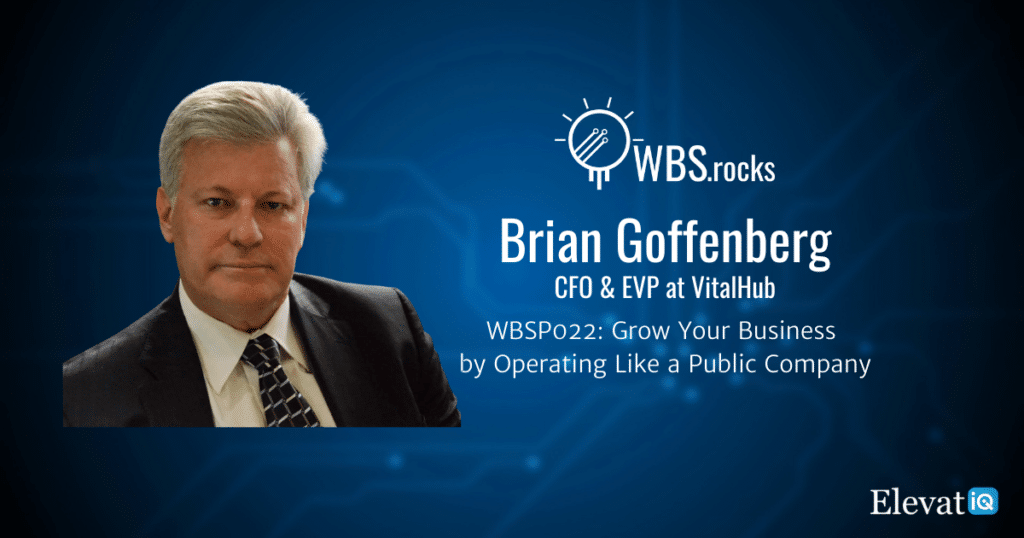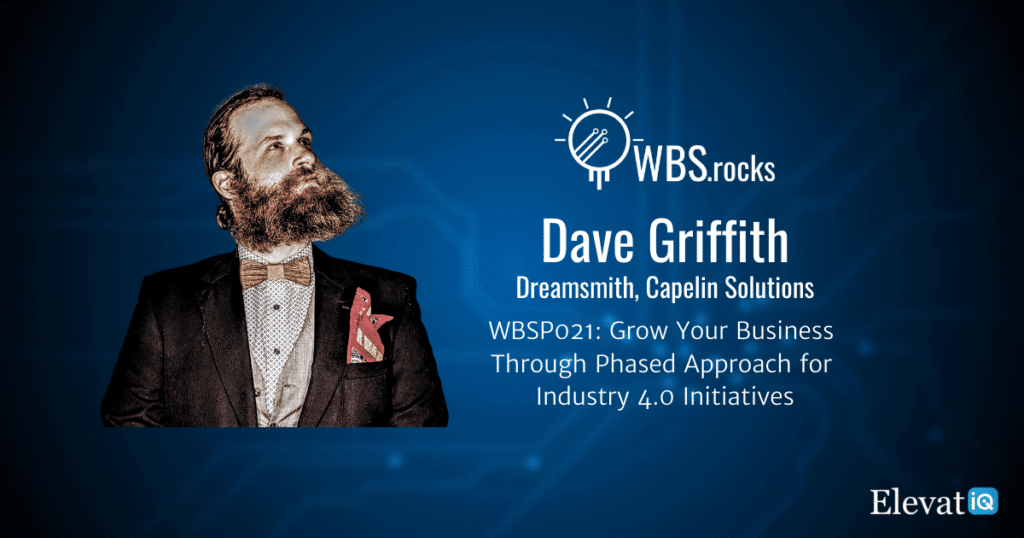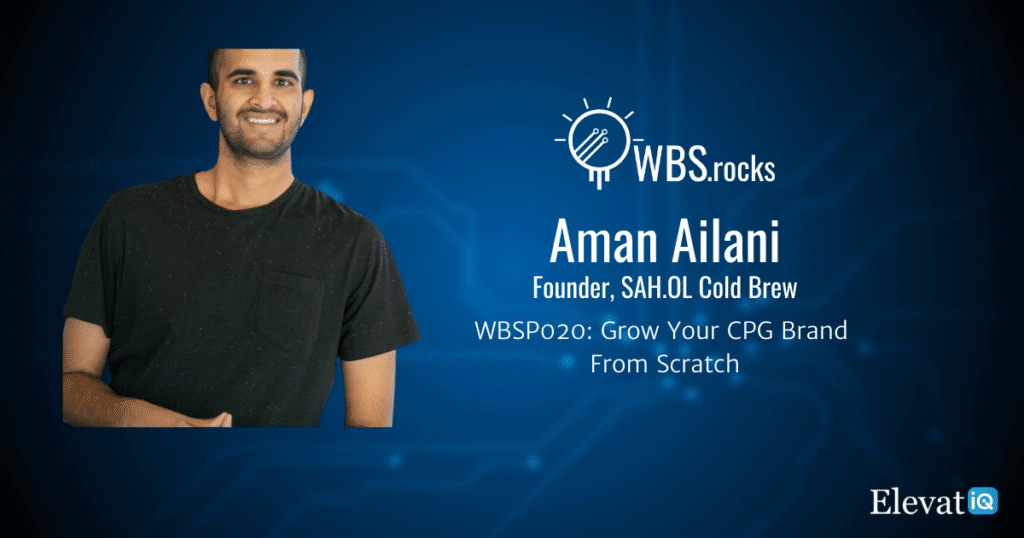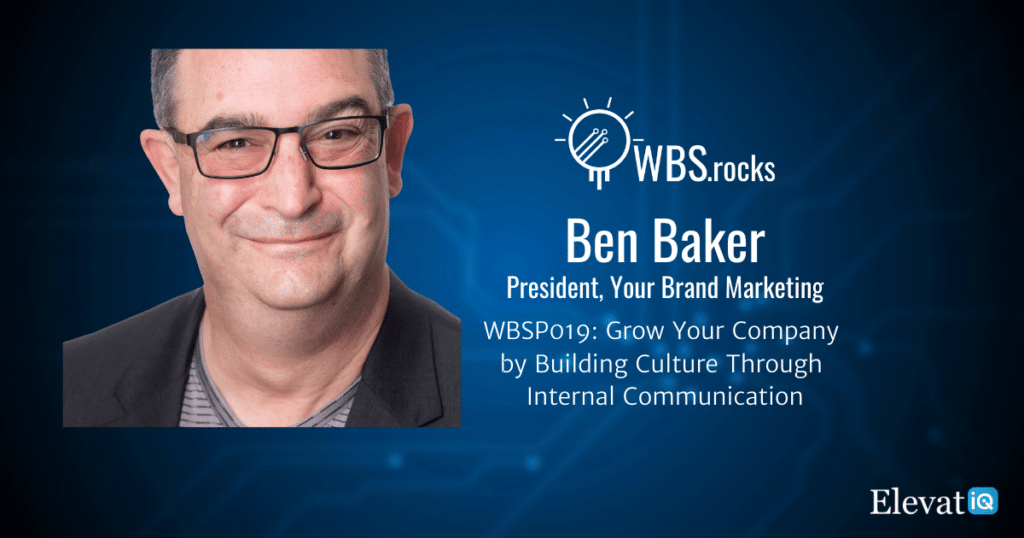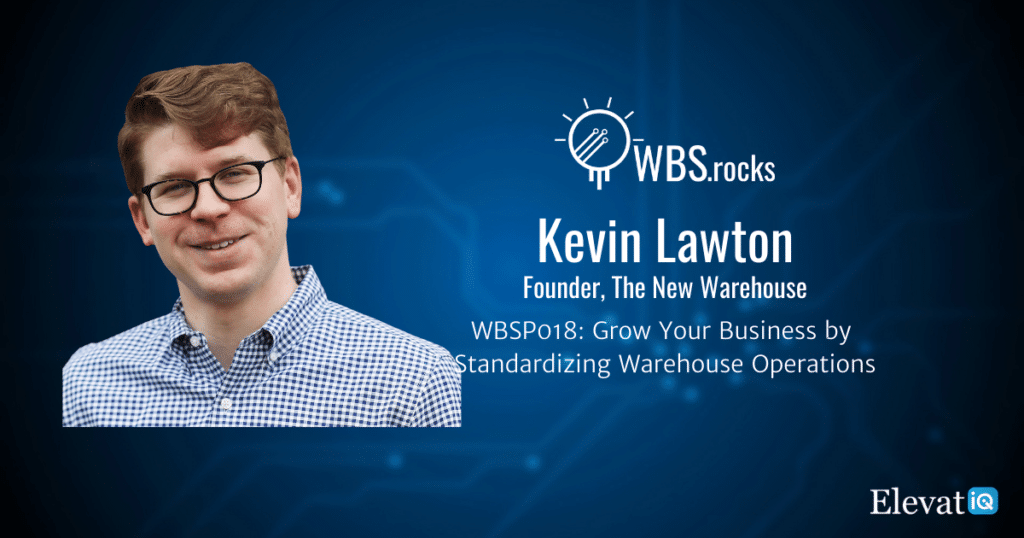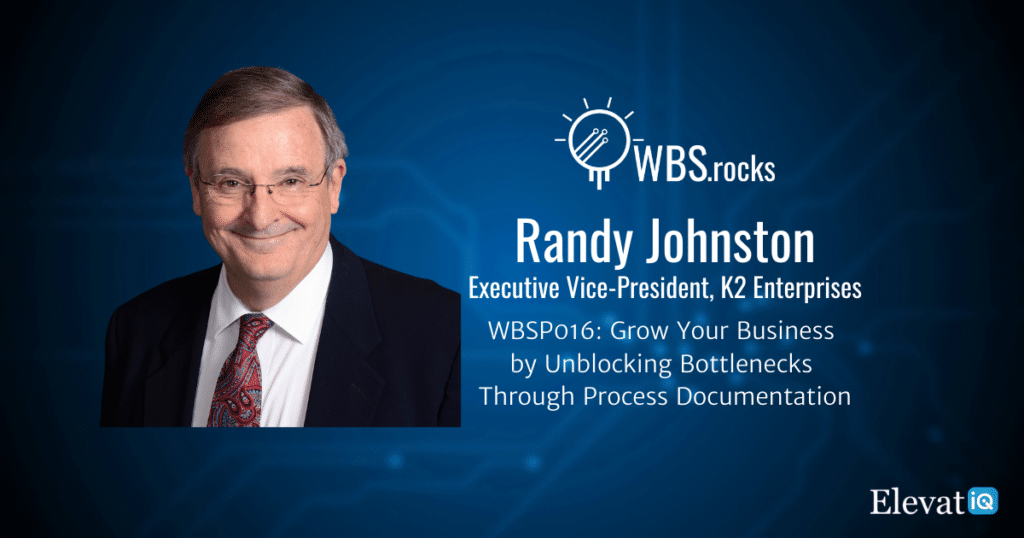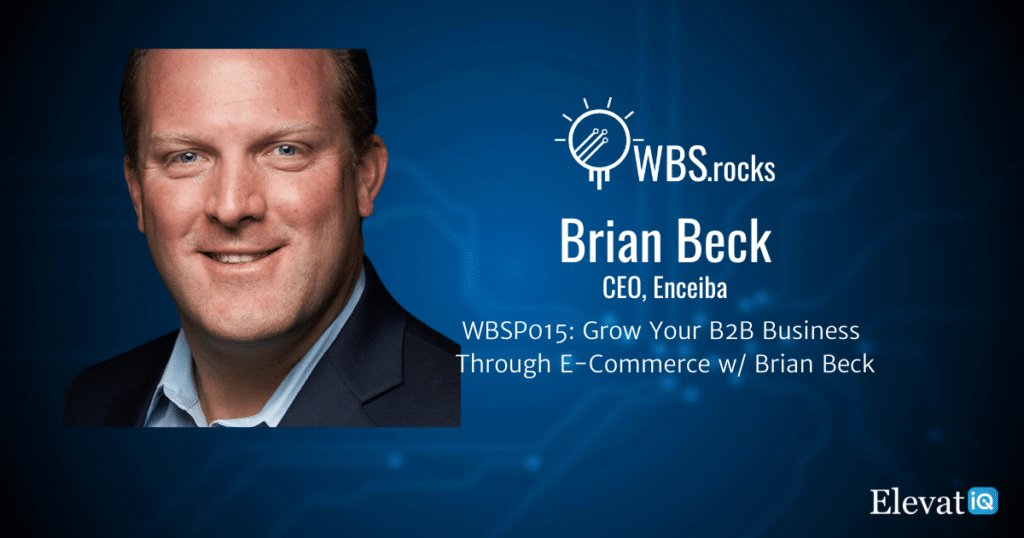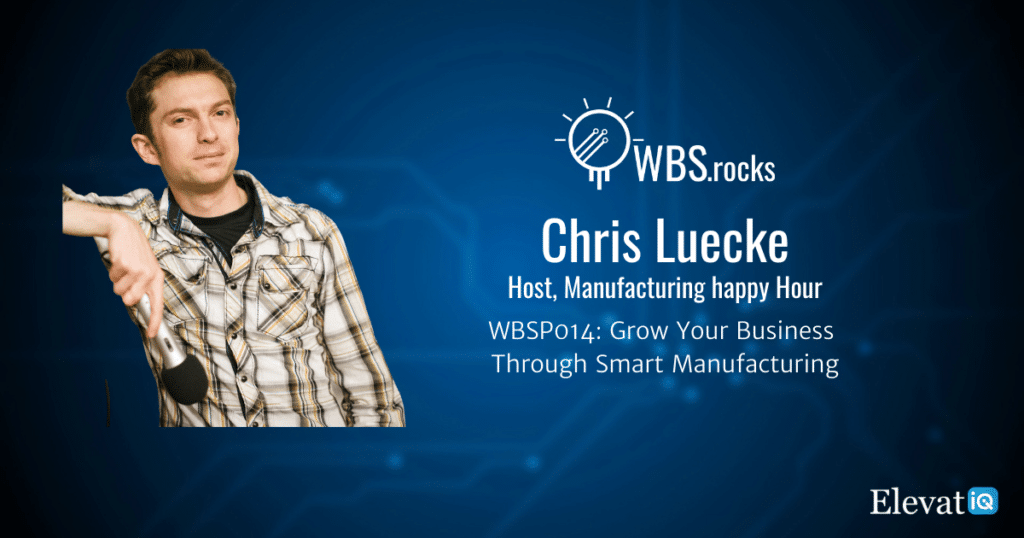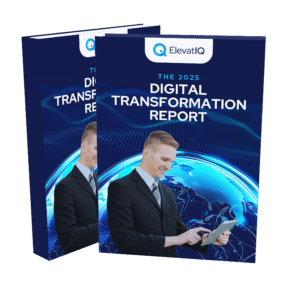WBSP022: Grow Your Business by Operating Like a Public Company w/ Brian Goffenberg
In this episode, we have our guest Brian Goffenberg from Vitalhub, who discusses the difference between accounting for a public and private company. He also touches on the importance of auditing and why most companies must consider getting audited by a public accounting firm despite its price tag. Finally, he shares his experience on the relationship between CFO and CEO and what new controllers and accountants need to know about this relationship.
Chapter Markers
- [0:00] Intro
- [2:57] Personal journey and current focus
- [4:23] Brian’s perspective on growth
- [6:09] What CFOs need to know about working with CEOs?
- [9:21] The skillsets differences for a CFO in public versus a private company
- [12:14] What do aspiring CFOs need to know about crossing the line?
- [17:08] 3-5 qualities of great and least desirable qualities of CEOs and CFOs
- [23:26] When are financial executives legally liable in their role?
- [26:23] The importance of auditing for SMB companies
- [30:48] Closing thoughts
- [32:18] Outro
Key Takeaways
- Don’t ever cross the line if anyone pushes you. And I’ve seen it in numerous organizations with a CEO or a CFO to an area where they’re not comfortable with, you’ve got to push back, and it’s that’s probably your duty, you’ve got to make sure that you’re compliant and that you’re not allowing the business to go down a path that it shouldn’t.
- As soon as you compromise yourself, if you have done it once, you just can’t undo it. So you have to set that line. And part of it is communication. It’s really going into, if you feel someone is pushing, pushing too hard in an area that you’re not comfortable with, you’ve got to talk about it.
- If your CEO does something that you think is off the line, and you try and approach him, and you try and get it dealt with, and it’s not getting dealt with satisfactory, you only have one real solution, and that’s to quit, and then find another job.
- To understand what it is to work in an organization where you don’t have cash, and you’re scratching and clawing to get money, whether it’s from customers from the bank to meet payroll, and then then you have a much better understanding of what it is to be in business.

Subscribe and Review
Apple | Spotify | Stitcher | Google Podcasts | Deezer | Player FM | Castbox
About Brian
Brian Goffenberg CPA, CA has expertise in the financial management of information technology firms, including Medworxx Solutions Inc., Philips Lifeline, DWL Incorporated, and Delrina Corporation, both before and after its 1995 sale to Symantec Corporation.
He has served as a financial partner and business advocate within a varied scope of organizations – and has served in leadership roles throughout trajectories of up to triple revenue growth. In addition to certification from the Canadian Institute of Chartered Accountants, Brian holds a Bachelor’s degree in Commerce and Accounting from the University of the Witwatersrand, Johannesburg, South Africa.
Resources
Full Transcript
Brian Goffenberg 0:00
To a CFO to an area where they’re not comfortable with, you’ve got to push back, and that’s part of your duty. You’ve got to make sure that you’re compliant and that you’re not allowing the business to go down the path that it shouldn’t.
Sam Gupta 0:13
Growing a business requires a holistic approach that extends beyond sales and marketing. This approach needs alignment among people, processes, and technologies. So if you’re a business owner, operations, or finance leader looking to learn to grow strategies from your peers and competitors, you’re tuned into the right podcast. Welcome to the WBS podcast, where scalable growth using business systems is our number one priority.
Now, here is your host, Sam Gupta.
Intro 0:49
Hey, everyone. Welcome back to another episode of the WBS podcast. I’m Sam Gupta, your host, and principal consultant at a digital transformation consulting firm, ElevatIQ.
If you’re a CEO of an SMB company, you might think that getting to $25 million in revenue is the hardest. However, if you ask anyone who has experience with an IPO or with the public companies reporting, the game completely changes when you go public. As a public company, you will have increased reporting needs and additional stakeholders such as the board and shareholders. If this is your first time reading a public company, you will need to game up your leadership and persuasion skills.
In today’s episode, we have a guest, Brian Goffenberg from VitalHub, who discusses the difference between accounting for a public and private company. He also touches on the importance of auditing and why most companies must consider getting audited by a public accounting firm, despite its price. Then, he finally shares his experience on the relationship between CFO and CEO and what new controllers and accountants need to know about this relationship.
Let me introduce Brian to you.
Brian Goffenberg, CPA, CA, has expertise in the financial management of information technology firms, including MedWorks Solutions, Inc., Philips Lifeline GWl In., and Delirina Inc., both before and after its 1995 sale to Symantec Corporation. He has served as a financial partner and business advocate within a varied scope of organizations and has served in leadership roles, role trajectories of up to triple revenue growth. In addition to certification from the Canadian Institute of Chartered Accountants, Brian holds a bachelor’s degree in commerce and accounting from the University of the Witwatersrand Johannesburg, South Africa.
With that, let’s get to the conversation.
Hey, Brian, welcome to the show.
Sam Gupta 2:57
Okay, to start off, Brian, you know, I would like to learn a little bit about you. Do you want to share your personal story and what you are focusing on these days?
Brian Goffenberg 3:05
I currently work for a software company called VitalHub Inc., a healthcare IT company, which trades on the Toronto Venture Exchange, was a company which my advice to see the CEO of the company, Dan Matlow, and myself purchased and then took it to took it public via RTL. I immigrated to Canada at the end of 1986. from South Africa, where I qualified as a CA and was bought to Canada by work by a company called Zipper Seven, which is where I worked for them for a number of years.
And then I’ve spent a number of years in industry working for private and public companies ranging from healthcare IT to technology, and including advertising. So I’ve had a wealth of experience in in the number of a number of different companies.
I like to consider myself more of as an operational CEO, CFO, and a great second support person for any organization. So my role as a team as a CFO is to really make sure that I’m supporting the CEO and giving him or him or her all the support that they need to be successful.
Sam Gupta 4:23
Okay, so one of the questions that I always ask, and obviously, I’m going to be digging deeper into some of the things that you mentioned during your intro. But before that, one of the questions that everybody needs to answer, whoever comes on the show, and that is their perspective on growth. So tell me, what is your position on growth?
Brian Goffenberg 4:43
I think, you know, any organization wants to grow. You have to challenge your organization’s set goals and make sure that you’re growing, but I do believe in managed growth. By manage growth, I mean that you’ve got to be able to grow the organization in a responsible fashion.
So If you’re, if you’re running a business and you want to have a business that’s less successful, you have to be profitable at some time. So, yeah, I see a lot of businesses going out and trying to create a lot of noise and come up with a try and drive revenue, but have no proper path to profitability.
Brian Goffenberg 5:19
And I just don’t think that’s sustainable. If you’re obviously a DotCom business or your business that’s looking just for eyeballs, you’ve got funded, you have tons of funding, and you’re able to take that money and just try and get subscribers and use there too. And your exit is to just exit by selling your subscriber base.
But otherwise, I don’t think you’re going to if you’re going to grow a business. You’ve got to have a profit path to profitability. And it should be pretty, pretty close. You don’t want to have that, that path, and that that gate too far. So yeah, I think it’s very important to make sure, you know, obviously, you’re going to plan for funding and make sure that you get the right funding to allow you to achieve that goal. And anytime that you do any planning, you have to plan for some contingencies, which are going to arise along the way.
Sam Gupta 6:09
Okay, so I want to go back to one of the comments that he made during your intro for CFO being the support person for the CEO. This is very important. I definitely agree with you there. In fact, I have personally written an article, which talks about overall the skills that CFO needs to have in talking to CEOs. And sometimes, the CEO may have a finance background. Sometimes they might not. Sometimes they may understand the nuances of finance and accounting, and sometimes they might not appreciate it.
So what would be your perspective? Let’s say if I have a new CFO, who is starting in their career, and they want to learn how to work with a CEO, what would be your perspective on that?
Brian Goffenberg 7:01
I think you got to understand. I think being the CFO, you’ve got to have obviously, you’ve got the technical skills. So you’ve gone through a super amount of training, and you’ve got some really good technical skills, probably way more advanced than then you’re than your CEO has your CEO typically has a lot of other skill sets, which you don’t have, and you got to recognize that you don’t have them.
And you got to be able to make sure that the CEO has the information has information and knowledge is power, to give them that the information and support to grow the business. And it’s going to be timely, and it’s going to be smart, and it’s going to be good information. So your role you’re going to understand you yet may be technically smarter, or you may have better training than your CEO because CEO is there for a reason.
And this has accomplished the role for a lot of good, probably a lot of good reasons. Now, you have to also be in line with your CEO. When I say the line, you have to make sure that you believe in what the CEO does if you don’t believe in what the CEO is trying to achieve.
Brian Goffenberg 8:01
And CEOs will push you. They’ll push the envelope in any business that they’re typically pretty positive. And when I say positive, they’ll push the envelope, and they keep people like keep wanting me to move the business forward, and you may stumble, you hit a roadblock, they’ll typically work out how to get around that Roadblock, you may come up with some solutions and some technical ideas and see where things aren’t always going well.
But they would typically look at the grass is always greener to them. And they can always push forward. So you’ve got to make sure that one is that you’re comfortable with it with this CEO and that they have the right level of integrity, don’t ever cross the line if there’s ever you may be pushed along the way. And I’ve seen it in numerous organizations with a CEO or a CFO to an area where they’re not comfortable with, you’ve got to push back, and it’s that’s probably your duty, you’ve got to make sure that you’re compliant and that you’re not allowing the business to go down a path that it shouldn’t.
So it’s really important, I think to be in step with the CEO, you can argue or debate. These debates are healthy, and it helps move things forward and understand your role and know that you can always disagree and beg to disagree, but continue and work forward to help the organization.
Sam Gupta 9:21
So I want to go back to some of the scenarios are public versus the private company. In the case of a private company, you are only working with the CEO. But obviously, as you mentioned, the CEO has a tough job. They need to talk to the shareholders. And I don’t know how much CFO is involved, and maybe you can talk about that as well.
But I mean, you, as a public company, are trying to convince a lot more people than just as CEO. So how does the job change? When you are a public company versus a private company?
Brian Goffenberg 9:56
I think the stakeholders are still the same. You see you’ve got you got the CEO, you’ve got the shareholder, depending on, you know, with a public company or with a private company, you know, it might be closely held, you might have a VC that is expecting you, other people that are backing you, if it’s just you working for CEO and who owns the company, it’s, it’s a very different dynamic, or, you know, sometimes you could work for a family-owned company. And there’s another dynamic where you’ve got to deal with a family. And some families are functional, some are dysfunctional, and you’ve got some challenges. You may have some challenges there.
Brian Goffenberg 10:28
But if you’re working for a private company, that’s, that’s owned by the has taken in some outside money, whether it’s VC, whether it’s bank financing, you’re responsible to those other shareholders, and you’ve got to make sure that you’re providing them with honest and the right information. So how it differs when you get to a public company, now that all the information is out there, it’s in the public domain, you’re, you’re purchasing quality financial financials, your business is being monitored and being judged on a quarterly basis.
So you really have to be aware of what you’re putting out the information that you’re putting out. And when I say aware, you understand that everyone has that, that information yourself to be aware with a public company, that you can’t give more information to some people than others. So, you know, there’s someone signed an NDA, they don’t, they can’t get certain information, but people are trading on the information that they receive.
Brian Goffenberg 11:24
So you have a responsibility to all shareholders who are out there who are getting information from you. And the amount of information that you can provide and people are comfortable with you. Giving up depends on the relationship I think you have with the board and the CEO. And if they’re comfortable with what you what you’re telling the street, let’s find out, then you’ll be able to give out more information and have more conversations with people in the street.
If they’re not, and you’re not involved in the operation, and you’re not involved with the business as much, then people will want you to have less communication with the street with a private company, it’s pretty much controlled, you’ll be talking to the board, and you’ll be talking to individual shareholders, but probably the CEO would probably control most of that.
Sam Gupta 12:14
Okay, so I want to go back to one of your comments that you made about the pushback. It actually reminds me of some of the exams that I have written as part of my CFA journey. And I remember those ethics questions. They used to be very difficult, extremely, extremely difficult. My head used to spin reading those questions.
So obviously, your info and reports are great, but it depends upon the person who was interpreting them. Sometimes, it could be challenging to pursue it to communicate. So when it comes to pushback, what are some of the things that newer CFOs can learn in terms of skills so that they are able to persuade and they are not crossing the line? I think you mentioned that term as well. Right? And in terms of ethics, you need to be super careful, especially if you’re running a public company. Oh, my goodness. I mean, that’s a tough job. So you need to be ethical, but at the same time, you also need to please your board and CEO. So how do you do that? Brian?
Brian Goffenberg 13:19
I think he has to say that draw a line in the sand where you say, Fine, I can go, you know, I can push the business I can, you can push me so far. But I’m not gonna break, and why am I not gonna break? I’m not gonna step over them. And I’m not going to do anything that I don’t believe is right. And that, that’s unethical, that’s going to compromise my integrity.
Because as soon as you compromise yourself, once you’re done, you just can’t undo it. So you have to set that line. And part of it is communication. It’s really going into, you know, if you feel someone is pushing, pushing too hard in an area that you’re not comfortable with, you’ve got to talk about it.
And you’ll talk to the individual. I will say to my staff typically is if I’m doing anything that you see that I’m doing something that’s not appropriate, come and speak to me. And if I’m not giving you if I don’t come up with a great solution, or you think that, that you’re still not comfortable with what I’m doing, or, or how I’ve changed or anything like that, then you go to my boss and you tell him, and that checks and balance that I have.
Brian Goffenberg 14:20
And I believe all people should have that same type of check and balance, but they should be they should have that internally so fine to say, if I’m going down a path that I don’t feel comfortable with, I have to bring it up, and the first person to bring it up is to speak to your superiors who is the person who is pushing you down that line.
And if they don’t understand your situation, or if they don’t see it the way you see it, and you’re still uncomfortable with the way it’s being dealt with, you know, they may see and say, oh, yeah, I understand and let’s do something else, always they don’t do they still going down a path which you’re not comfortable with.
Then get hold of someone on the board, and you’ve got to find someone that you feel comfortable with and discuss it with them. And they make it they may say well, yes They might either with you or disagree with you, but they’ll come up with them, they should be able to help you with the solution. If they can’t, then you’ve got a bigger issue because, you know, you may be down a path that you that you’ve just you’re not comfortable with completely and then you may, you may have to leave the organization,
Sam Gupta 15:18
Okay. And related to this, the ethical questions are not really as black and white. They are very great. And that’s what makes them extremely difficult. And the risk is paramount because you have a risk of getting fired because, at the end of the day, you are actually reporting to the board and the CEO.
So obviously, you have a lot at stake. So it requires a lot of courage, in my opinion, to be able to bring these topics and talk about them. And sometimes that could be emotional as well. So what would be your perspective in terms of dealing with the situation? I know you have touched on this a bit, I would like to get a deeper perspective.
Brian Goffenberg 15:55
You have to be comfortable as being to see I mean. You’re working with this person. You should be working pretty closely. And as I say, you should be the person’s right hand, man or woman. To do that, you’ve got to get getting their confidence and their trust. And if you’ve got that, then they’ll speak to you, and they’ll be able to discuss items. If you don’t have that trust, then you’ve got a big issue because then you’re going to ask yourself, Is this something that I really want to do, or I want to be part of because both parties, both the CEO and the CFO have to understand their roles.
And if then stand how that kind of integral they are to each other. If you don’t, if your CEO doesn’t feel that your, your, your role is then important to him or her, then you’re probably not doing as good a job as you should be doing. You need to try and bridge that gap and trying to understand what it is that that person needs and the support that they need for you to be successful.
And you’ll find that out pretty soon. You’ll see, and you’ll be able to see if you’re successful if they come to you for information and coming to discuss things with you. If they are just ignoring you, and they’d left you in the backyard a typical bean counter type thing here: just give me the numbers, and I’ll be happy. You may not be in the right place.
Sam Gupta 17:08
Okay, so on that point, I would like to touch on a couple of more things related to the CFO and CEOs relationship. So let’s say if you were to name some CEOs that were your absolute favorite, okay, you could name them if you don’t want to name them, that’s okay, as well.
What I’m really looking for is the five qualities three to five qualities that you appreciated in them, the best CEOs, and not-so-good CEOs, and if they may have some qualities that you didn’t appreciate as much, so maybe you can talk about that.
And then I want to do the same thing with CFOs as well. So I’m pretty sure you have some peers, three to five qualities that you appreciated about the CFO, and three or five qualities that you don’t appreciate in some CFOs.
Brian Goffenberg 17:56
When I first saw that when I joined the company called Delrina, which was a public company way back which got bought out by a company called Symantec, which has all the antivirus software, I worked for a CFO named Mike Cooperman. He was a phenomenal mentor. He pushed us, challenged us, and allowed us to, to sort of thriving in an environment where we were running, you’re trying to grow a business.
And it was a pretty successful business. I think he is probably one of the biggest exits in Canadian software history. I think it’s sold for about $461 million. But Mike would push you, would allow you to make mistakes, and would allow you to push the envelope on a super simple IP made sure that you learned along the way that you continually try to improve the business end, and just would give you advice along the way.
Brian Goffenberg 18:46
As far as CEOs, I worked for a great CEO called Lynn Wexler when I was at Lifeline, which helped me to go forward by Philips Lifeline to lifelines of personal emergency response systems for the elderly, layin, once again, we challenge you he would be he was pretty direct.
So there was one thing that you had to get used to. So if there was a problem or something, he would tell you, and he wouldn’t mince words, and will really hold you accountable to whatever you did push you to do your best push you for continuous improvement. And we have probably one of the biggest most, one of the most rigorous planning processes that I’ve been involved with, with Lifeline.
Brian Goffenberg 19:27
And because we did that, we spend a ton of time and effort in the planning process. We typically knew that we would at least meet and exceed our results on a regular basis. And I say the land was just one of those people that challenge you that put it out there, and you know that you could do whatever you like, and his doors would be open at the end of the day.
You knew that he was in charge, but and you better prepare when you come to a meeting, and you come to speak to him because you didn’t want to waste the individual’s time. So I think those qualities are those things that you got to be paid to be pushed. And you got to be prepared to be challenged, thinking just be an environment that you thrive in.
If it’s, you know, some people don’t like the operational side of a business, and then don’t get involved in it, stay and do the areas, the concentrated areas that you’re comfortable with, whether it’s just you know, Stricker county technical accounting, I know, I went through a ton of training on the technical side of accounting, it’s not my strength, and it’s not an area that I enjoy, I enjoy the operational side of the business, one that I’ve been trying to make sure that time is effective as possible, as an operational CFO.
Sam Gupta 20:38
Okay. So when I look at the analysis, I typically like to make it comprehensive. So obviously, you spoke about the qualities that you admire in a CEO and CFO, but we did not get a chance to discuss the qualities that you don’t admire. And that is equally important as well because that is actually going to provide us a lot of learning. So again, you don’t have to name anyone here. But I would like to talk about some qualities that you didn’t appreciate, either in a CEO or CFO.
Brian Goffenberg 21:06
And on the sheer side, I’ve worked with people who want to say push the envelope, and I think it went over the line and I wouldn’t, I wouldn’t want to, I don’t want to work with those types of people. I just think people who, who don’t respect the position that the CFO position or respect what you have to offer.
And when they first start out in the industry, you work for someone, and you sit there, there’s no real, what I call it Whistleblower Protection. Yeah, they talk about in public companies, and then, but as an individual, you sitting there, and if your CEO does something that you think is off the line, and you try and approach him, and you try and get it dealt with, and it’s not getting dealt with satisfactory, you only have one real solution, and that’s to quit, and then find another job. If you don’t have the resources to quit and think, then you end up staying around and buying your time until you find the right opportunity.
Brian Goffenberg 22:02
But you’re working in a pretty tough environment. So I think what you’ve got to do upfront is in the interview process, understand who you’re dealing with as best as possible, and spend a ton of time and energy researching the individuals to make sure that they do have the integrity and that that they do have the maybe the same type of goals and aims that you have, I’ve worked for a number of people that I would never work for, again, just because I think either they crossed the line or they just weren’t as honest as they as they could have been.
And you don’t have to tolerate that. You’ve got to. I think you’ve got to make sure and ask yourself. I mean, I remember one working for one company and one of the individuals one of the senior people in the company came to me one day, and he said, Well, he how he evaluates whether the company is the right company for him, he asked himself one question, and this is, and you’d only appreciate this if you have a family.
Brian Goffenberg 22:55
He also questions is what I need my children to work here. And if you think about that, it’s a pretty interesting question because most of us will tolerate a lot more than we let our kids tolerate. And I remember he asked the question to yourself and ended up leaving within a month.
I asked myself the question too. I had the same answer as him. But at the time, I didn’t have any financial resources to leave. So I stuck around a little bit longer than I probably should have. But it’s, I think it’s a really interesting question. This is one that you can appreciate if you do have a family.
Sam Gupta 23:26
Okay, so let’s talk about the journey of an accountant. Obviously, when anyone starts in their finance or accounting career, they are going to be starting with a position that is probably not going to be as comfortable. And when I look at the accountability, I am looking at, let’s say, the signature on a legal paper where you are going to have legal obligations personally, and I keep hearing this news.
And I don’t know, to be honest, I mean, in terms of the overall journey, how much CFO is accountable, and let’s say if something happens to the company, or with respect to reporting, the consequences could be including, you know, getting some jail time, right, which is extremely, you know, sad and severe, that nobody wants to see.
So, in terms of accountability, when does that accountability start? Does it start at the comptroller role? Does it start at the CFO role, or are they never going to be touched, and the responsibility is really on the CEO and shareholder to make sure that the reporting is accurate, and CFO is not going to be legally accountable for anything.
Brian Goffenberg 24:32
I think the day the day that you take on and that you decide you want to be a CFO, or whatever, you take on that role, and you take on that accountability. And that’s one thing that I think you have to understand that you have, as you said, you talked about ethics and that product, or your training is that you take on that role, so you cannot allow yourself or to stray and to to do anything that’s unethical. That’s illegal.
It’s just, you know, people rely on you the reason why you’ve called it That the CFO, the controller than what anyone can do to finance it because there’s a huge responsibility, you’ve got you controlling the cash, you’re typically dealing with banks, you’re dealing with it with the recording of what the corporation’s any of the corporations, movement, and operations.
Brian Goffenberg 25:20
So it starts from day one, it doesn’t, you don’t suddenly wake up and become have that role. It’s the, and it’s, it’s, you have to make sure that you don’t step over the line and are training to be lousy to do that. The chair that you know, the challenges as most organizations, once you, as soon as you’ve quantified you’ve got the wealth of knowledge.
And you want to use that I encourage all people getting into business when you are starting out in any role to be patient when you start because typically, you will have probably more knowledge and your skill set at the time because your newly qualified grad will probably be more technically your technical competence will be probably more than most of the people that you’re working for.
But just remember, they have a lot of experience, they’ve been down this path, and you can learn a lot from them. So I think to be patient, learn as much as you can, absorb as much as you can, but speak up when you would see that you can add value.
Sam Gupta 26:23
Okay, so one of the questions that I really wanted to cover as part of this interview is your auditing experience. Brian, you have been an auditor for a long time. And in my customer base, when I look at anything below $25 million manufacturing and distribution companies, they are not necessarily getting audited. So tell us what the importance of auditing is and why everyone should consider auditing. If you think that, you know, everyone should consider auditing.
Brian Goffenberg 26:52
So everything’s interesting. I’m a fan that I always used to say to people what a thing was there was a wave of public accounting firms to try and convert you from being an entrepreneur to being a technical auditor. Because you have to do this three years in my name instead of three years or sending of articles with an accounting firm.
So you go in there, as you probably did, you’ll see it because you want to become an entrepreneur, you saw a lot of CEOs became CFOs. So that was kind of the path you wanted to travel. But then you get to have to do the three years of articles. I think, you know, when I look back at what I did, and how I learned during that time, I think what you really want to do during that time period is it’s a great opportunity to learn and see how different businesses run.
Brian Goffenberg 27:41
Should companies be always audited? Yes, they should. I think it just gives them a good opportunity to see what controls the challenge with an audit that I found was just so historical. By the time you finish the audit term, the company could be under. They’ve moved on. And you’re really just providing you know, if the company has run well, you’ve confirmed what they’re doing, if it’s not done well and they and the issues you’re you’re coming up with issues, which probably operationally aren’t good anyway.
And the business itself may or may not be in it have its own problems. But I think from an auditing perspective. It’s a great opportunity to learn to see you may decide that it’s a career that you’d like it’s not, you know, being a partner in an in a CPA firm is a pretty decent career. And you can do pretty well out of it. Just be patient and learn is probably the biggest bit of advice.
Brian Goffenberg 28:34
The other thing that that I learned once long my career what I had one part that was really great as being an audit in Anderson, Arthur Andersen in those days, what it was around was a pretty fair amount of competition among people and what have you.
So you did you kind of rush when I say rescue if you try and do it as fast as possible to make sure that you, you’re meeting deadlines, and etc., but and I was on the job and one of the parties turned around to me, so Well, what do you know about the inventory, and I looked at him, I suddenly I showed him my working papers, which are fantastic, you know, well, well laid out, etc.? He says to me, whoa, do yourself a favor. When you go to accounting, spend a day or two with a CEO, CFO, just walk around with them, talk to them, and then understand the business and then start auditing.
Brian Goffenberg 29:23
And they’ve made so much sense when I looked at it, because suddenly now I started learning a bit about businesses learn more about the business instead of just working in spreadsheets and not understanding the businesses. So I think one of the big things taken out of that is if you’ve got an opportunity while you’re auditing to understand the trend, learn about businesses, to speak to some pretty smart to individual CEOs, CFOs are different organizations and use it and get as much as you can out of it.
Another thing too that you’re going to realize when you come out of that once you’ve done that, depending on how much time you spent with them on the operational side, and most auditors don’t spend much time, and I find that most orders come out, pretty rich don’t really understand the business side of things.
Brian Goffenberg 30:09
So, you know, they have a very technical and accounting side, but on the business side really don’t understand much. And I maintain on the business side. If you really want to understand the business, you have to go through it. You have to be working in an organization where you can’t afford when you have the challenge to make payroll because then you start understanding cash flow.
And you understand what really drives the businesses. You’ve always heard the term cash is king. It is. To understand what it is to work in an organization where you don’t have cash, and you’re scratching and clawing to get money, whether it’s from customers from the bank to meet payroll, and then then you have, I think, a much better understanding of what it is to be in business.
Sam Gupta 30:48
Okay, amazing. So that’s it for today. Brian, do you have any last-minute closing thoughts?
Brian Goffenberg 30:53
I think if you’re going down this journey, I think it’s a great journey to go down. Be honest with yourself, define what type of role you want to be in, and be honest with what you’re capable of doing. You know, a lot of people sit there to say, Yeah, I want to be CEO, I want to be an operational CFO.
But they’re not prepared to understand or learn the business side of things. And I’m not comfortable on the business side of things and not comfortable dealing with people. Make sure that you were comfortable with whatever role you want to take on the patient and just work to the best of your ability, and you’ll be successful.
Sam Gupta 31:28
That’s amazing, Brian. This is a super powerful insight. And I’m sure this is going to be very helpful for your peers and the people who are starting their journey. So I thank you so much for your time and insight.
Brian Goffenberg 31:42
Thank you very much. And so if anyone wants to reach out to me for your anything, I’m happy to help companies who are starting out of going down or going down different processes can reach out to me, and I’d love to help, and I’d love to, to impart some of the knowledge and that I have gained over the years.
Sam Gupta 32:05
Okay, and we are going to be including your contact information, Brian, and the links that you are going to send out in the show notes so they can check there as well and they can connect with you.
Brian Goffenberg 32:15
Thank you.
Sam Gupta 32:16
I cannot thank our guests enough for coming on the show for sharing their knowledge and journey. I always pick up learnings from our guests, and hopefully, you learned something new today. If you want to know further about Brian, please visit vitalhub.com. He is also active on LinkedIn and available for any board or advisory work and would be happy to mentor individuals.
He also encourages everyone to follow his current CEO, Dan Matlow, and VitalHub on LinkedIn as he is one of the best CEOs he has ever worked with and is proud of the culture that he has created at VitalHub. VitalHub is proud of an open culture where you don’t have to be afraid to challenge anyone. Links and more information will also be available in the show notes.
If anything in this podcast resonated with you and your business. You might want to check other later episodes, including the interview with Randy Johnston from K2 Enterprises, who touches on why process documentation is an essential ingredient for an efficient finance organization. Also, the interview with Wayne Sadin who brings a unique perspective on why business processes are more important for growth than individual business systems.
Also, don’t forget to subscribe and spread the word among folks with similar backgrounds. If you have any questions or comments about the show, please review and rate us on your favorite podcasting platform or DM me on any social channels. I’ll try my best to respond personally and make sure you get help.
Thank you, and I hope to get you on the next episode.
Outro 33:57
Thank you for listening to another episode of The WBS podcast. Be sure to subscribe on your favorite podcasting platform so you never miss an episode. For more information on growth strategies for SMBs using ERP and digital transformation, check out our community at wbs.rocks. We’ll see you next time.

